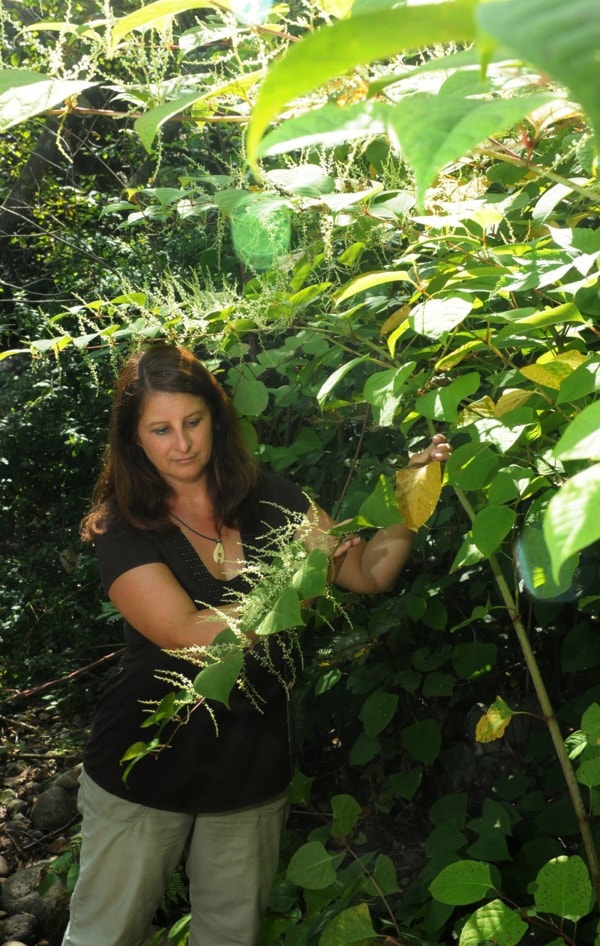A destructive invasive plant called Japanese knotweed has taken root in Maple Ridge and Pitt Meadows, and is threatening to damage roadways, crack building foundations and destroy fish habitat.
The bamboo-like plant is strong enough to bore through concrete and so virulent, it can regrow from as little as 0.2 grams of root remains.
"It's impossible to dig them up," says Jennifer Grenz of the Invasive Species Council of Metro Vancouver, which has been working to eradicate the infestation in the Lower Mainland.
"Their roots can reach [five metres] deep and 20 metres across."
Grenz likens knotweed to an iceberg.
"What you see is often only a fraction of the plant. The root systems are massive which is where the threats to infrastructure and septic fields are," she said.
The plant was first introduced to B.C. as a landscaping shrub that provided homeowners with privacy and shade. However, the plant soon grew out of control in its new environment, Grenz said, outcompeting native vegetation and completely taking over ecosystems.
"Maple Ridge is an ideal place for it to grow," said Grenz. "It's one of the worst infested areas in the Lower Mainland."
Eradication crews from the Invasive Species Council of Metro Vancouver are working to contain the spread of Japanese knotweed along Lougheed Highway in Pitt Meadows, as well as Kanaka Creek Regional Park.
Maple Ridge Coun. Cheryl Ashlie said raising awareness about Japanese knotweed is the first step to stopping its spread.
"I don't think people realize how destructive it is," she said. "Until they see the damage themselves, I don't think they understand."
Earlier this year, an infestation of Japanese knotweed was discovered splitting concrete in the footings of the Ironworkers Memorial Bridge and infesting a section of the Highway 1 expansion project in Burnaby.
Since 2007, the U.K. government spent the equivalent of $110 million to eradicate four hectatres of Japanese knotweed from the Olympic Park in London, prior to the construction of Olympic venues, according to the Royal Horticultural Society.
That plant has caused so much damage to house foundations in the U.K., in some cases homes have been condemned. Banks may even refuse to offer mortgages on properties where the plant is found.
Grenz cautions against trying to dig out the plants, as they will inevitably grow back.
"The worst thing you can do it try to mow over it or take a weed-whacker to it," she said. "That will only make it worse."
Dumping yard waste containing knotweed can also cause it to spread.
In May, eradication crews working in Kanaka Creek Regional Park found close to 70 kilograms of knotweed yard waste that had been illegally dumped in the park.
"Someone likely tried to clear their property, and dumped it there," said Grenz.
Now the knotweed has spread, taking root on properties adjacent to the park.
To kill the plant, eradication crews must inject a herbicide called glyphosate, the active ingredient in Round-Up. Smaller plants require targeted spraying.
Grenz said that while she understands public concerns regarding the use of herbicides and pesticides, there is no other way to effectively kill the plant. She added the targeted use of glyphosate leaves nearby plant species unharmed.
While the use of Round-Up is restricted for cosmetic purposes under the District of Maple Ridge's cosmetic pesticides bylaw, because the province has identified the Japanese knotweed as an invasive noxious species, it is legal to use the herbicide to kill it.
"The provincial law supersedes the local bylaw," said David Boag, facilities manager for Maple Ridge Pitt Meadows Parks and Leisure Services.
Parks and leisure services are currently developing a strategy to deal with the infestation locally. Boag said the first step is to conduct an inventory of the plant to determine the extent of the infestation.
"We are still in the very early stages," Boag said. "There's a lot of work that needs to be done."
The Alouette River Management Society has already spent $3,000 to eradicate Japanese knotweed on private land along the Alouette River over concerns it poses to fish habitat.
Acting executive director Greta Borick-Cunningham said the plant crowds out other species, such as salmonberry and vine maple, eliminating food sources for local faunae.
"The animals and the birds won't go anywhere near it," she said.
Knotweed roots can also cause increased soil erosion along riverbanks. More silt is washed in waterways as a result, damaging fish spawning grounds.
"It's very much a matter of containment," said Borick-Cunningham. "Now that it's here, we may never get rid of it completely."
How to fight knotweed
• Don’t mow or weed whack as it will spread the plant
• If you attempt to dig it out you must dig all of it out. Roots can go five metres deep so it may not be possible.
• Any biomass cannot be composted and needs to go to the dump or be burned if you are able to do that
• Round-Up applied to the foliage is effective but follow up treatments will be needed over one to two years
• Natural herbicides (horticultural vinegar) will not work on knotweed as it only burns the foliage. To effectively kill knotweed a systemic herbicide is needed to target the roots.
• For more info, visit www.iscmv.ca
